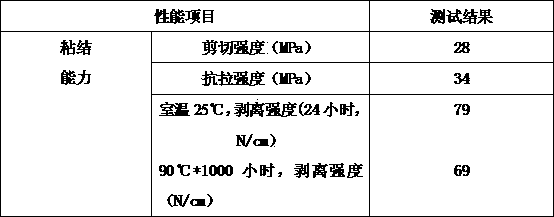Solvent-based neoprene adhesive
A chloroprene rubber and adhesive technology, applied in the direction of adhesives, non-polymer organic compound adhesives, etc., can solve the problems of poor storage stability, large initial viscosity, poor cold resistance, etc., and achieve low cost and environmental protection. The effect of good resistance and excellent heat and chemical resistance
- Summary
- Abstract
- Description
- Claims
- Application Information
AI Technical Summary
Problems solved by technology
Method used
Image
Examples
Embodiment
[0014] A solvent-based neoprene adhesive, made of the following raw materials in parts by weight: 115 parts of styrene, 120 parts of ethyl acetate, 24 parts of neoprene CR121, 18 parts of xylene, 4,4'-diphenyl 1.5 parts of methyl methane diisocyanate, 10 parts of polyisobutylene, 3 parts of 3-aminopropyltrimethoxysilane, 3 parts of polytetrahydrofuran ether glycol, 4 parts of SG-2 type PVC resin, 1.5 parts of ferrocene, chlorohydrin rubber 12 parts of H45, 6 parts of epoxy resin modified polyamide hot melt adhesive, 3 parts of zinc oxide, 16 parts of nano calcium carbonate, 12 parts of bentonite, 1.6 parts of anti-aging agent NBC, 1.5 parts of anti-aging agent MB, accelerator Na-22 1.5 parts, accelerator DM 1.6 parts, N-(β-aminoethyl)-γ-aminopropyltrimethyl(ethyl)oxysilane 3 parts, bis(dioctyloxypyrophosphate)ethylene titanate 2 parts, 1.6 parts of antioxidant 1035, 22 parts of fast extruded carbon black N660, 1.5 parts of zinc stearate, 6 parts of triethyl citrate, 4 parts of...
PUM
 Login to View More
Login to View More Abstract
Description
Claims
Application Information
 Login to View More
Login to View More - R&D
- Intellectual Property
- Life Sciences
- Materials
- Tech Scout
- Unparalleled Data Quality
- Higher Quality Content
- 60% Fewer Hallucinations
Browse by: Latest US Patents, China's latest patents, Technical Efficacy Thesaurus, Application Domain, Technology Topic, Popular Technical Reports.
© 2025 PatSnap. All rights reserved.Legal|Privacy policy|Modern Slavery Act Transparency Statement|Sitemap|About US| Contact US: help@patsnap.com

